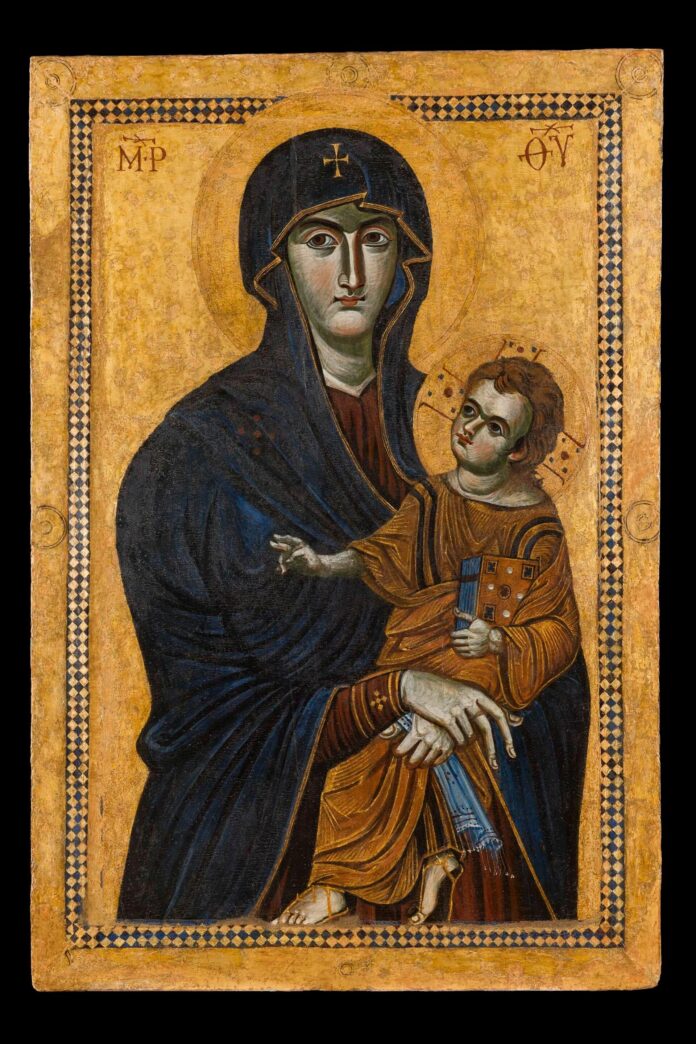The icon Salus Populi Romani (Safeguard of the Roman People) is venerated as a sacred image of the Virgin Mary, emblematic of Marian devotion in Rome. Its origins are believed to date back to the 5th or 6th century, during the first stirrings of Christian faith in the Eternal City. According to tradition, this icon was brought to Rome to protect the city during major trials, particularly periods of plague or natural disasters. Its name, "« Salus Populi Romani »" translates an invocation of the Virgin as protector of the Roman people, an appellation directly linked to the biblical faith in the power of Mary as intercessor, notably in Luke 1:28 where the Angel Gabriel says to her: "Greetings, full of grace, the Lord is with you." (Lk 1:28).
The Basilica of Saint Mary Major, an iconic sanctuary
Located on the Esquiline Hill, the Basilica of Saint Mary Major is the principal place where the icon is kept and venerated. For centuries, this basilica has been a focal point for prayer and Marian devotion. Tradition sees it as a concrete representation of the "dwelling place of the Virgin" promised in Isaiah 4:5-6: "Over all the glory that covers Israel shall be a tent and a canopy, when the Lord takes refuge in the glory." (Isaiah 4:5).
A protective icon, a symbol of faith and Roman identity
A thousand-year-old tradition of spiritual protection
For centuries, Salus Populi Romani embodies the constant supplication of Roman Christians for divine protection against trials. The belief is based on Mary's role as Salus – salvation, protection – mentioned several times in the Bible. For example, in Luke 2:38, the prophetess Anna expresses her gratitude to God: «She praised God and spoke about the child to all who were seeking the redemption of Jerusalem» (Luke 2:38). Devotion to this icon strengthens prayer for Mary’s power in times of crisis.
The icon and the major Roman crises: plague, wars, pandemic
The history of Rome is marked by major crises during which the intercession of Mary, particularly through the veneration of this icon, was invoked. During the previous plague, tradition recounts that Pope Sixtus IV prayed before the icon in 1477, then insisted that the image be carried throughout the city, an act recalling the biblical promise in 2 Chronicles 20:9: «If calamity comes upon this land, if wrath or plague or the sword is unleashed against them, they shall come before you […], and you shall hear their prayer.» (2 Chronicles 20:9).
Papal devotion: from Leo XIV to Pope Francis
Leo XIV and the continuity of an ancestral veneration
Pope Leo XIV, as a great defender of Marian devotion, always renewed his prayer before Salus Populi Romani. In his speeches, he invoked Mary as "the safe refuge of the Roman people" (a characteristic the Bible associates with Mary in Luke 1:48: "For he has looked with favor on the lowliness of his servant" – Luke 1:48). Proximity to this icon represented for him an act of faith, trust, and divine protection.
Pope Francis, a faithful pilgrim before Salus Populi Romani
More recently, Pope Francis has repeatedly expressed his devotion to the icon, particularly during major pilgrimages and tributes to the Virgin Mary. In 2018, he prayed before this icon during a Mass at Saint Mary Major, linking his prayer to the biblical promise that Mary is our refuge in distress: « >>(Psalm 46:1).
Spiritual and artistic legacy of Salus Populi Romani
The importance for Marian devotion in Rome and beyond
Salus Populi Romani is more than just an icon; it is the enduring symbol of a thousand-year-old relationship between Rome, the Virgin Mary, and the people of God. Biblical tradition also emphasizes Mary's power as mediator in 1 Timothy 2:5: «For there is one God and one mediator between God and mankind, the man Christ Jesus» (1 Timothy 2:5). Faith in Marian protection is therefore founded on this divine mediation and on Mary's exemplary role in the history of salvation.
Donation, restoration and enhancement through the centuries
Since its earliest depictions, the icon has undergone several restorations, notably in the late 19th and 21st centuries, to preserve its beauty and meaning. The Bible encourages the value of faithfulness and transmission in Matthew 28:20: «And surely I am with you always, to the very end of the age» (Matthew 28:20). The preservation of Salus Populi Romani testifies to this faithfulness to the faith.


